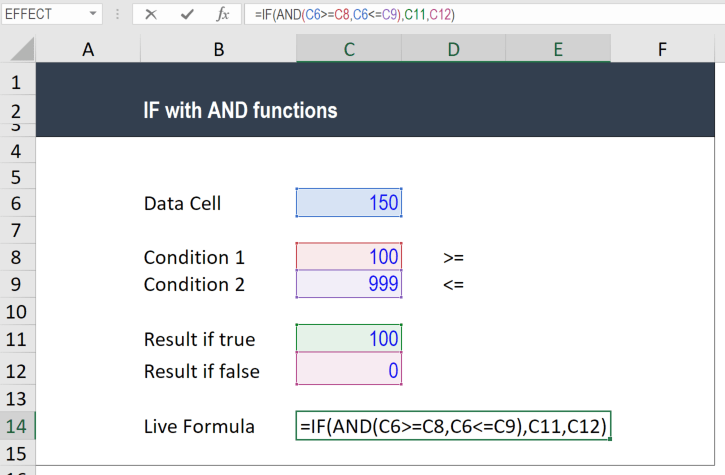Excel For Mac If Statement With Multiple Conditions
20.01.2019by admin
- If Function In Excel With Multiple Conditions
- Excel If Then Statements Multiple Conditions
- Excel For Mac If Statement With Multiple Conditions Synonym
- If Statement With Multiple Conditions Java
Following up on last week’s, here’s one on how to use Excel’s IF statement when you have multiple conditions to meet. The original question I received from a reader, which prompted this series, was about how to use the IF statement in Excel when you had two conditions that had to be met. For example, when sales fell between a minimum and maximum number. Let’s take a look at our example again.
If Function In Excel With Multiple Conditions
Note that I’ve added the maximum amount of $200K into cell B3: Before we go further, if you’d like to work through the examples yourself, here’s the raw data you can copy into an Excel worksheet. First, open up a blank excel worksheet. Next, highlight the table below. Copy it, and then go back to your excel worksheet.
Excel If Then Statements Multiple Conditions
Go to cell A1 (or another empty cell, if you want to put the data elsewhere), and then select “Edit” from the menu bar. Select “Paste Special” and then “Text” from the popup box. The data should appear in your Excel worksheet just as it does above. Bonus 12% Minimum amount 100000 Maximum amount 200000 Sales Bonus Salesman A 87925 Salesman B 100000 Salesman C 145000 Salesman D 200750 Salesman E 178650 Salesman F 99555 Salesman G 147000 Salesman H 213450 Salesman I 122680 Salesman J 92500 Ok, now back to the tutorial. Now, let’s suppose sales have to be greater than or equal to $100K and less than $200K for a salesman to receive a 12% commission rather than just be greater than $100K, as in our introductory example. How would you write that in “Excel-speak”? It turns out that you can use, which Excel calls a logical operator (just like it calls the IF function).
Excel For Mac If Statement With Multiple Conditions Synonym

If Statement With Multiple Conditions Java
Create Multiple IF Statement And Multiple VLOOKUP Within Same Formula Aug 11, 2014 I am trying to create a formula which looks in 1 cell to determine 'IF' it states either 'BUTT CUT' or 'DIE CUT' and then does a VLOOKUP in a table array for each which ever column relates to asnwer to 'IF statement. Hi there, I am working on a sheet that requires an IF statement with three total criteria. I have attached the worksheet for easy reference. Here is what I need. Multiple IF AND statements excel. Excel If statement evaluating multiple cells for substrings. Multiple conditions in formatting Excel cell.
And, as usual, unlike how most other programming languages work, the syntax required in Excel is a bit different. To use it correctly, you have to write it like the following: =AND(first condition, second condition,, etc.) (In other programming languages, AND would fall in between each condition, just like how we normally talk, but not in Excel!) Let’s go back to the concrete example. To write the condition that sales have to fall betwen $100K and $200K for the salesman to receive a 12% commission, we’d write the following in cell C6: =IF(AND(B6>=$B$2, B6. Here’s how the results look if we do this for all the salesmen in our example: There are two other logical functions, and, which work the exact same way: =OR(first condition, second condition,, etc.) =NOT(first condition, second condition,, etc.) For example, we could actually rewrite our IF statement above using the OR condition if we’re careful.
Here’s how it would look: =IF(OR(B6=$B$3),”No bonus”, B6*$B$1) Like this: Again, in plain English, what we’re saying is, “If B6 is less than B2 or B6 is greater than or equal to B3, put ‘No bonus’ into the cell. Otherwise, multiply B6 by B1.” We’re basically testing for the opposite conditions in our OR statement as we did in our AND statement. And you’ll get the same results as above with the AND statement, as seen below: You might be able to picture now how you could start using multiple AND, OR, and IF statements nested altogether to test all sorts of complicated conditions in Excel. But keep in mind that cells in Excel are really meant more for doing calculations than programming, which is really what you’re getting into once you start putting in complex IF statements. (I’ve read somewhere you can nest up to 7 IF statements in Excel, though I’m not sure to which version(s) of Excel that limitation applies.) In particular, coming up with a correct list of conditions to test for, in the right order, that don’t result in a false positive test (e.g. A condition accidentally being met that you didn’t mean to) is a big concern in Excel.
Best media player for mac. The other problem is usability. Even if you were able to come up with a complex IF statement that did what you wanted it to, imagine you put the spreadsheet away and revisited it again in a year’s time when you had to update annual sales figures and calculate bonuses again. Here’s an example of a complicated nested IF statement with no other logical operators: =IF(A1.